Types of Website: Which One Fits Your Purpose?
Ever wondered why websites look and work so differently from each other? That’s because they’re built with a purpose—and that purpose influences everything, from layout and visuals to features and functionality. Some are made to sell, some to tell stories, some to connect people, and others to inform or entertain.
Each type of website follows a unique web design approach that reflects its goals. For instance, e-commerce sites focus on product visibility and seamless checkout, while portfolio websites prioritize visuals and personal branding. News portals aim for readability and quick navigation, whereas community forums emphasize interaction and user-generated content.
Whether you’re launching your own website or just exploring the web landscape, understanding the different types of websites—and how their design aligns with their purpose—can give you a clearer perspective. From online stores to personal blogs, from educational platforms to SaaS applications, every website has a role to play in today’s digital world.
Let’s break down the most common types of websites you’ll come across, and explore real-world examples that show how thoughtful design brings function and purpose together.
Different types of websites
The internet is filled with websites—each designed with a unique purpose. From selling products to sharing ideas, here’s a breakdown of the most common types of websites with example:
Business / corporate websites
These are digital platforms designed to represent a company’s brand, values, and offerings online. Their primary goal is to provide information about the business, including services, products, mission, team, and contact details. They often feature professional design, company portfolios, testimonials, case studies, and lead generation forms to build credibility and attract potential clients or partners.
Example: IBM’s corporate website is a prime example of a business website. It showcases the company’s wide range of enterprise solutions, from cloud computing to AI services. The site emphasizes professionalism through detailed service pages, customer success stories, whitepapers, and easy navigation, making it a reliable digital presence for a global tech leader.
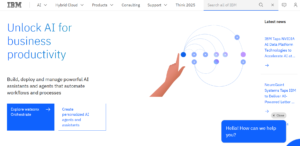
E-commerce websites
Shopping has evolved from crowded marketplaces to clicks and carts—thanks to e-commerce websites. These platforms typically feature a product catalogue, search and filter tools, shopping carts, secure checkouts, order tracking, multiple payment options (credit/debit cards, UPI, wallets, cash on delivery), and responsive customer support.
Example: Flipkart, a top-tier e-commerce giant, offers an extensive range of products across electronics, fashion, home decor, and more. With features like flash sales, user reviews, easy returns, and diverse payment modes—including EMI and pay-later options—Flipkart ensures a seamless and trustworthy shopping experience for millions of users.
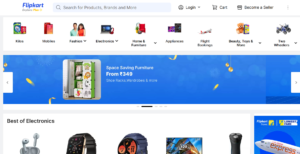
Portfolio websites
Think of these as digital resumes with personality. Portfolio websites are used by creatives, professionals, and freelancers to showcase their work, skills, and achievements. They often include project galleries, client testimonials, an “About Me” section, and contact forms to attract potential clients or employers. Clean design and visual storytelling are key elements that make a portfolio stand out.
Example: Deepak Bothra’s portfolio is a strong example of how consultants and content creators can build a credible online presence. As a YouTuber and consultant, he uses his website to share insights, showcase his expertise in business and personal finance, and highlight the value he brings to his audience. The site reflects professionalism while keeping the tone approachable and authentic.

Blog / personal websites
When someone wants to share their thoughts, experiences, or expertise with the world, a blog or personal website is the way to go. These platforms are often content-driven and cover topics ranging from lifestyle and travel to technology and mental health. They include posts, comment sections, social media links, and subscription options to engage readers and build a community.
Example: Mark Manson’s personal website is a blend of blog and personal brand. Known for his raw, insightful takes on life and self-improvement, his site features bestselling book promotions, newsletters, and a blog that attracts millions of monthly readers.

Educational websites
Learning is no longer confined to classrooms—educational websites bring knowledge to your fingertips. These platforms are designed to provide learners of all ages with access to courses, tutorials, study material, quizzes, and certifications. Whether it’s academic subjects, professional development, or hobby-based learning, these websites often feature video lessons, interactive content, and flexible learning paths.
Example: Khan Academy is a globally recognized educational website offering free, high-quality lessons in subjects like math, science, economics, and more. With interactive exercises, instructional videos, and a personalized learning dashboard, it empowers students, teachers, and lifelong learners to study at their own pace.
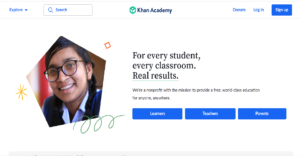
Non-profit / charity websites
Non-profit and charity websites focus on spreading awareness, driving donations, and inspiring action. These platforms highlight the organization’s mission, ongoing projects, impact stories, and ways to get involved. They often include donation gateways, volunteer sign-up forms, event information, and regular updates to keep supporters engaged.
Example: Water is a powerful example of a non-profit website that uses storytelling, visuals, and transparency to connect with donors. The site showcases real-world impact, offers easy donation options, and lets contributors track the progress of water projects they’ve funded across the globe.
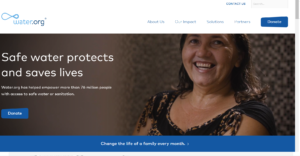
Entertainment websites
Designed to engage and amuse, entertainment websites cover everything from streaming movies and music to celebrity news, games, and fan communities. These platforms prioritize rich media content—videos, podcasts, memes, and articles—with features like subscriptions, playlists, and interactive elements to keep users hooked.
Example: Netflix is a leading entertainment website that offers on-demand streaming of movies, TV shows, and documentaries. With personalized recommendations, multiple user profiles, offline viewing, and diverse global content, Netflix redefines digital entertainment for users around the world.
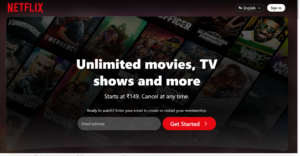
News / magazine websites
Stay informed, stay ahead—news and magazine websites deliver timely updates, in-depth articles, and expert opinions on current events, lifestyle, business, politics, entertainment, and more. These platforms prioritize readability and fast content delivery, featuring breaking news tickers, category filters, multimedia content, and subscription models.
Example: BBC News is a globally trusted news website that offers up-to-the-minute reporting across various categories. With a clean layout, regional editions, video news, and fact-based journalism, it ensures a credible and engaging reading experience for audiences worldwide.
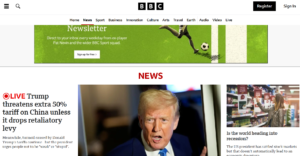
Forums / community websites
These platforms are vibrant hubs where people come together to share ideas, ask questions, and engage in discussions. They often feature threaded conversations, user-generated content, moderation tools, and various interest-based subforums to help users connect over shared passions and experiences.
Example: Reddit is a prime example of a community website. With its diverse subreddits covering everything from news to niche hobbies, Reddit fosters lively discussions, user interactions, and a sense of belonging among its millions of active members.
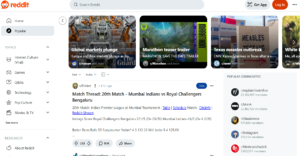
Membership websites
Membership websites offer exclusive access to premium content, services, or communities through subscription models or one-time payments. They provide tailored experiences for members, such as in-depth articles, specialized courses, video tutorials, or private forums, making them ideal for building loyal, engaged audiences.
Example: Medium’s Membership platform exemplifies this model. By offering exclusive stories, in-depth articles, and an ad-free reading experience to subscribers, Medium creates a community of engaged readers who value high-quality content and insightful perspectives.
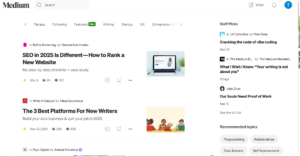
Directory & listing websites
These websites act as digital catalogs, helping users find businesses, services, professionals, or places based on category, location, or ratings. They typically include searchable listings, filters, user reviews, contact details, and sometimes maps or booking options—offering value for both users and listed businesses.
Example: Justdial is a popular Indian directory website that lists local businesses, service providers, and professionals. Users can search, compare, read reviews, and even book services directly through the platform, making it a go-to resource for local discovery.
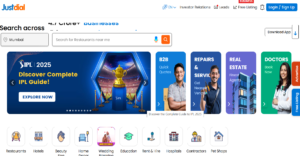
SaaS / web application websites
Bringing software to your fingertips—SaaS and web application websites deliver powerful tools directly through your browser. These platforms offer scalable, subscription-based solutions with features like secure logins, customizable dashboards, real-time analytics, and seamless integrations, empowering businesses to streamline operations without the hassle of traditional software installations.
Example: Salesforce is a leading SaaS platform that revolutionizes customer relationship management. With its comprehensive suite of cloud-based tools, users can manage sales, customer service, marketing campaigns, and analytics—all through an intuitive web interface that adapts to the needs of businesses of all sizes.

Event websites
Designed to build excitement and drive attendance, event websites serve as the digital hub for conferences, concerts, webinars, festivals, and more. They typically include event details, schedules, speaker bios, ticket booking, venue information, and registration forms—often paired with countdown timers and promotional content to boost engagement.
Example: TEDx Events have dedicated websites for each independently organized event, offering information on speakers, agendas, ticketing, and past talk recordings. These websites not only inform but also inspire attendees and speakers to be part of a global knowledge-sharing community.
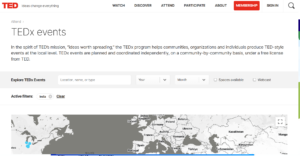
Comparison / review websites
Helping users make smarter choices, comparison and review websites evaluate and contrast products, services, or experiences across key features, pricing, and performance. These platforms often include user-generated reviews, expert ratings, pros and cons, and buying guides—empowering consumers with the insights they need before making a decision.
Example: CNET is a popular tech review and comparison website that covers everything from smartphones to software. With in-depth reviews, comparison charts, and editor picks, CNET helps millions of users stay informed and confident about their tech purchases.

Government websites
Government websites act as official digital gateways for public services, information, and citizen engagement. They offer access to government schemes, documents, forms, updates, and e-governance tools. Built for transparency and convenience, these platforms often feature multilingual support, secure authentication, and online service applications.
Example: India’s official government portal—serves as a comprehensive resource for citizens, offering information on government departments, public services, schemes like Digital India, Aadhaar, and more. It connects users with essential resources such as birth certificates, tax filings, job listings, and social welfare programs—all in one centralized platform.
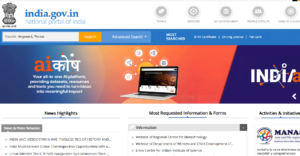
Crowdfunding websites
These platforms turn ideas into reality by allowing individuals, startups, or organizations to raise funds from a large number of people—typically in small amounts. Crowdfunding websites often include campaign pages with goals, storytelling videos, progress trackers, reward tiers, and social sharing options to attract backers and build community support.
Example: Ketto is one of India’s leading crowdfunding platforms, widely used for medical emergencies, social causes, and creative projects. With a user-friendly interface, real-time donation tracking, and built-in sharing tools, Ketto makes it easy for fundraisers to reach donors and amplify their impact.
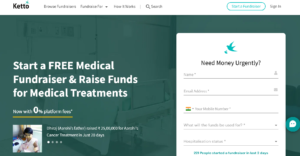
Recipe / food websites
The recipe and food websites are go-to platforms for culinary inspiration, meal planning, and cooking tips. These sites typically feature step-by-step recipes, ingredient lists, cooking videos, nutrition info, and user ratings. Some also offer meal prep tools, grocery lists, or regional cuisine guides.
Example: Sanjeev Kapoor’s website is a popular Indian recipe platform that offers a wide variety of dishes—from traditional Indian curries to global cuisines. With detailed instructions, cooking tips, and videos by the celebrity chef himself, it’s a favorite among home cooks across the country.

Travel websites
Whether you’re planning a weekend getaway or a world tour, travel websites help turn dream trips into reality. These platforms offer destination guides, booking tools, travel blogs, hotel and flight comparisons, itinerary planning, and reviews—making travel research and booking smooth and stress-free.
Example: MakeMyTrip is one of India’s top travel websites, providing services for flights, hotels, trains, buses, and holiday packages. With customer reviews, real-time booking options, and travel deals, it’s a one-stop shop for both casual and frequent travelers.
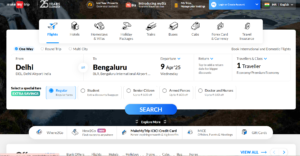
Health & wellness websites
Health & wellness websites promote physical, mental, and emotional well-being through informative and interactive content. These platforms typically include blogs, fitness routines, meditation guides, diet plans, symptom checkers, and even teleconsultation features—helping users take charge of their health from anywhere.
Example: HealthifyMe is a leading Indian wellness app and website that offers personalized fitness coaching, calorie tracking, workout plans, and AI-powered nutrition advice. With real-time support and progress monitoring, it’s a go-to platform for people striving to live healthier lives.
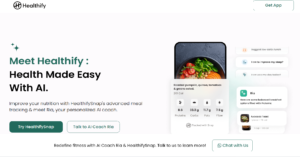
Real estate websites
Buying, selling, or renting a property? Real estate websites simplify the process by offering detailed property listings, photos, virtual tours, filters, price comparisons, and direct contact with agents or owners. These platforms also feature location maps, EMI calculators, legal advice, and market insights.
Example: 99acres is one of India’s most trusted real estate websites. It connects buyers, sellers, and renters with verified listings, neighborhood details, builder profiles, and more—making property search efficient and transparent.
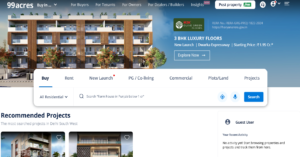
Horoscope / astrology websites
Blending ancient wisdom with modern tech, astrology websites offer daily horoscopes, birth chart analysis, zodiac predictions, and personalized readings. Many also include tarot, numerology, gemstone suggestions, and access to professional astrologers for consultations.
Example: AstroSage is a leading Indian astrology website that provides Kundli generation, personalized horoscopes, Vedic predictions, and live consultations. With multi-language support and a user-friendly interface, it’s a trusted source for astrological insights.
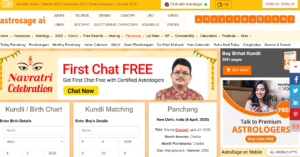
End note
Understanding the different types of websites is essential for anyone looking to build a strong and purposeful online presence. Each website serves a specific function—whether it’s driving sales, sharing information, building a community, or showcasing creative work. By identifying the right type of website for your goals, you can ensure better user experience, clearer communication, and more effective results. As the digital world continues to evolve, having a well-structured website tailored to your audience remains one of the most powerful tools for growth and connection.
Looking to create a website that aligns with your goals?
Start by choosing the right type of website tailored to your purpose and audience. A well-structured, goal-driven site is the first step toward building a strong and credible online presence. Let your website work for you—strategically and effectively. Contact us!

